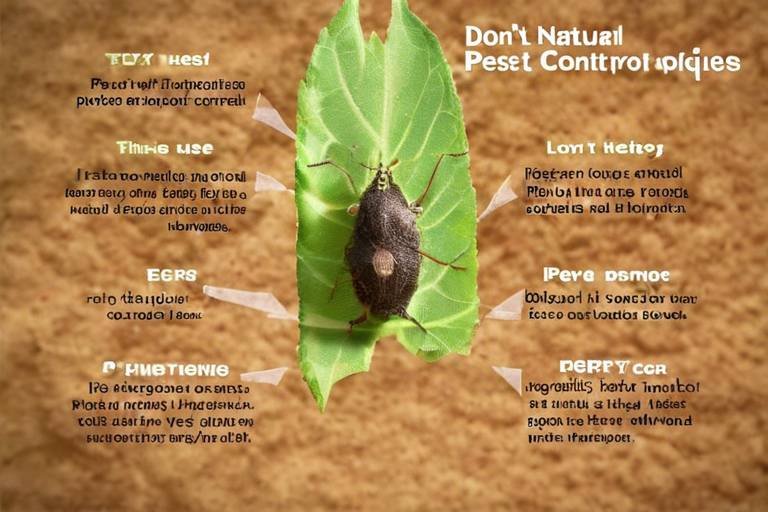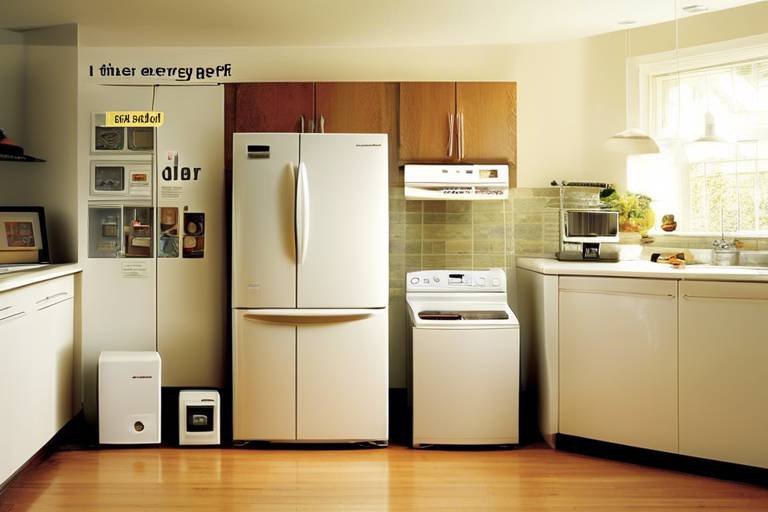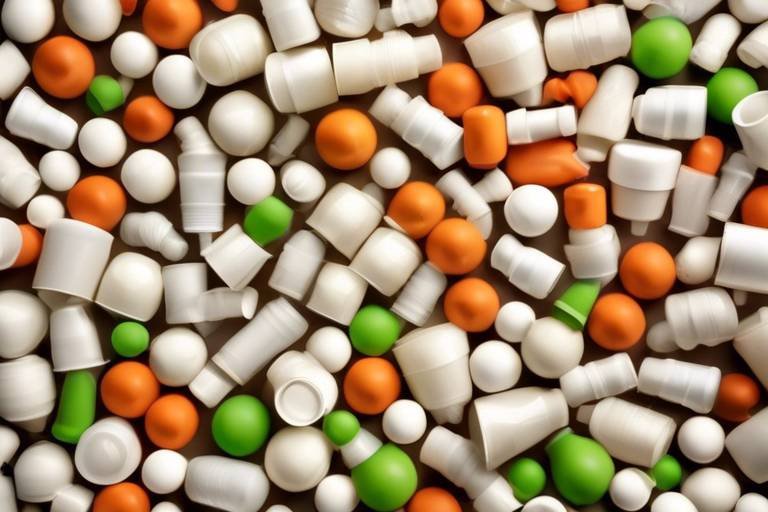Eco-Friendly Alternatives to Household Disposables
In today's fast-paced world, the convenience of disposable household items often overshadows their environmental impact. However, as awareness grows about the detrimental effects of these products on our planet, many individuals are seeking sustainable alternatives that not only reduce waste but also promote a healthier lifestyle. Imagine a world where your daily choices contribute positively to the environment rather than depleting it. By making small changes in our purchasing habits, we can collectively make a significant difference.
Switching to eco-friendly alternatives is not just about saving the planet; it's also about enhancing our health and well-being. Many disposables contain harmful chemicals that can leach into our food and environment, affecting our health in the long run. By opting for natural and biodegradable products, we can create a safer home environment for ourselves and our families. Furthermore, these alternatives often prove to be more economical in the long run, as they are designed for reuse or are made from materials that decompose naturally.
So, what are some practical steps we can take to replace those pesky disposables? The options are plentiful and accessible! From compostable tableware to reusable shopping bags, each alternative presents a unique opportunity to reduce our ecological footprint. Not only do these products help in minimizing waste, but they also encourage a mindful approach to consumption. By choosing products that are kind to the Earth, we are also supporting businesses that prioritize sustainability.
As we delve into this article, we'll explore various eco-friendly alternatives to common household disposables. We'll look at biodegradable products, reusable items, and even eco-friendly cleaning solutions that can transform the way we maintain our homes. By the end of this journey, you'll be equipped with the knowledge to make informed decisions that benefit both your household and the environment.
Are you ready to take the plunge into a greener lifestyle? Let's embark on this exciting journey together and discover how simple changes can lead to a profound impact on our planet!
- What are biodegradable products? Biodegradable products are designed to break down naturally in the environment, reducing pollution and waste.
- How do I dispose of compostable items? Compostable items should be placed in a compost bin, where they can decompose effectively. It's important to separate them from regular waste.
- Are reusable products really cost-effective? Yes! Although reusable products may have a higher initial cost, they save money over time as they can be used multiple times.
- What are some eco-friendly cleaning brands? Look for brands that use natural ingredients and have sustainable packaging. Some reputable ones include Seventh Generation and Mrs. Meyer's.

Understanding the Impact of Disposables
In today's fast-paced world, the convenience of disposable products often overshadows their significant environmental consequences. Each year, millions of tons of disposable items, from plastic cutlery to single-use bags, find their way into landfills, contributing to a growing crisis. Have you ever stopped to think about where these items end up after just one use? It’s startling to realize that a simple plastic fork can take hundreds of years to decompose, releasing harmful toxins into the soil and waterways during that time. This is a wake-up call for all of us!
The impact of disposables extends beyond just waste accumulation. They contribute to pollution, threaten wildlife, and exacerbate climate change. For instance, the production of single-use plastics emits greenhouse gases that contribute to global warming. Moreover, marine life often mistakes plastic debris for food, leading to dire consequences for ocean ecosystems. The statistics are shocking:
| Disposable Item | Time to Decompose |
|---|---|
| Plastic Bags | 10-1,000 years |
| Plastic Straws | 200 years |
| Styrofoam Cups | Indefinitely |
| Glass Bottles | 1 million years |
It’s clear that the **environmental impact** of disposables is not just a minor inconvenience; it’s a pressing issue that demands our attention. By understanding the consequences of our choices, we can make informed decisions that benefit not only our planet but also our health and communities. For example, many disposable products are made from harmful chemicals that can leach into food and drinks, posing health risks to consumers. Isn't it time we rethink our reliance on disposables?
In the quest for a sustainable lifestyle, being aware of the **impact of disposables** is the first step. By choosing alternatives, we can significantly reduce our ecological footprint and foster a cleaner, healthier environment for future generations. So, what can we do? The answer lies in embracing eco-friendly alternatives and making conscious choices that reflect our values. Together, we can turn the tide against disposables and pave the way for a greener future.

Biodegradable Products
In a world increasingly aware of its ecological footprint, have emerged as a beacon of hope. These innovative alternatives are crafted to decompose naturally, which means they break down into harmless substances over time, unlike their traditional disposable counterparts that linger in landfills for centuries. Imagine a world where your waste doesn’t contribute to the ever-growing mountains of trash; that’s the promise of biodegradable products. They are not just a trend; they represent a significant shift towards a more sustainable lifestyle.
Biodegradable options are available for many of the items we use daily, from plates and cutlery to bags and packaging. These products are made from natural materials, which are designed to break down through the action of microorganisms, making them a fantastic choice for environmentally-conscious consumers. For instance, instead of using plastic plates for your next picnic, you could opt for biodegradable plates made from plant fibers, which will decompose in a matter of months rather than decades.
One of the most exciting aspects of biodegradable products is the variety available on the market. Here’s a brief overview of some common biodegradable items you might consider:
- Compostable Plates: Made from materials like sugarcane or palm leaves, these plates are perfect for parties and gatherings.
- Biodegradable Cutlery: Often made from cornstarch or bamboo, these utensils are sturdy yet environmentally friendly.
- Biodegradable Bags: A fantastic alternative to plastic bags, these bags break down in composting conditions.
As you can see, the options are not only practical but also exciting! Transitioning to biodegradable products can significantly reduce your household's waste output and contribute to a healthier planet. But it’s essential to understand that not all biodegradable products are created equal. Some may require specific conditions to decompose effectively, so it’s crucial to research and choose products that align with your composting capabilities and local waste management practices.
In conclusion, embracing biodegradable products is a simple yet impactful way to make a difference. By opting for these sustainable alternatives, you’re not just making a purchase; you’re making a statement about the kind of world you want to live in. Every small change counts, and as more people choose biodegradable options, we can collectively reduce our reliance on harmful disposables and pave the way for a cleaner, greener future.
Q: What are biodegradable products made from?
A: Biodegradable products are typically made from natural materials like plant fibers, cornstarch, and other organic substances that can break down naturally.
Q: How long does it take for biodegradable products to decompose?
A: The decomposition time varies depending on the material and environmental conditions, but many biodegradable products can break down in a few months to a couple of years.
Q: Can I compost biodegradable products at home?
A: Yes, many biodegradable products are compostable, but it’s essential to check the specific product guidelines to ensure they can break down effectively in your composting setup.

Compostable Tableware
When it comes to hosting a party or even just enjoying a casual meal at home, the convenience of disposable tableware can be tempting. However, have you ever paused to think about the **environmental impact** of those plastic plates and foam cups? Enter —a game-changer in the world of sustainable dining. This innovative alternative is not only eco-friendly but also functional, allowing you to enjoy your meals without the guilt of contributing to landfill waste.
Compostable tableware is made from natural materials that can break down into organic matter in a composting environment. This means that instead of sitting in a landfill for hundreds of years, your plates, cups, and utensils can return to the earth in a matter of months. Imagine hosting a barbecue where all your tableware is not just a one-time use item but a part of the cycle of life, enriching the soil for future plants. Isn’t that a beautiful thought?
Many types of compostable tableware are available today, made from materials like sugarcane, bamboo, and palm leaves. Each type has its unique features and benefits:
| Material | Benefits | Uses |
|---|---|---|
| Sugarcane | Sturdy, microwave-safe, and made from a renewable resource. | Plates, bowls, and containers. |
| Bamboo | Biodegradable, lightweight, and has a natural aesthetic. | Utensils and serving dishes. |
| Palm Leaves | Durable, leak-resistant, and adds a rustic touch. | Plates and bowls. |
Using compostable tableware at your next gathering not only enhances the dining experience but also sends a message about **sustainability**. Guests will appreciate your commitment to the environment, and you’ll feel good knowing that you are making a positive impact. Plus, these products often look and feel just as good, if not better, than their plastic counterparts, proving that eco-friendly doesn’t mean sacrificing style.
However, it's essential to understand that simply using compostable tableware is not the end of the story. To ensure these products fulfill their promise of breaking down effectively, they need to be disposed of properly. Many people mistakenly throw them in regular trash, which can hinder their decomposition process. Instead, compostable items should be placed in a compost bin or a dedicated composting facility. This way, they can decompose into nutrient-rich compost, contributing to a healthier planet.
In conclusion, compostable tableware is a fantastic alternative to traditional disposables. It allows you to enjoy the convenience of single-use items while being mindful of our planet's health. So, the next time you plan a meal or a gathering, consider making the switch to compostable options. Your future self—and the Earth—will thank you!

Materials Used in Compostable Products
When it comes to compostable products, the materials used play a pivotal role in their effectiveness and environmental impact. Unlike traditional disposables that linger in landfills for centuries, compostable items are crafted from organic materials that can break down naturally, enriching the soil in the process. Some of the most common materials found in compostable products include:
- Sugarcane Bagasse: This byproduct of sugar production is a fantastic alternative to plastic. It’s sturdy, lightweight, and can decompose in a matter of weeks when composted properly.
- Bamboo: Known for its rapid growth and renewability, bamboo is not just a trendy material; it’s also incredibly durable. Bamboo utensils and plates are not only eco-friendly but also stylish!
- PLA (Polylactic Acid): Derived from cornstarch, PLA is a popular choice for compostable items like cups and containers. While it requires industrial composting facilities to break down efficiently, it’s still a step up from conventional plastics.
- Wood Pulp: Often used for plates and bowls, wood pulp products are biodegradable and can decompose quickly, making them an ideal choice for outdoor events.
These materials are not just a trend; they represent a significant shift towards sustainability. For instance, sugarcane bagasse is not only a waste product but also a renewable resource, making it an excellent choice for eco-conscious consumers. Similarly, bamboo’s rapid growth cycle means that it can be harvested sustainably without harming the environment.
However, it’s essential to understand that the effectiveness of these materials depends on the right composting conditions. For example, while PLA products are compostable, they often need specific temperatures and conditions found in industrial composting facilities to break down effectively. On the other hand, materials like bamboo and sugarcane can decompose in backyard composting systems, making them more accessible for the average consumer.
In summary, choosing compostable products made from these innovative materials not only helps reduce landfill waste but also supports a circular economy. By opting for items made from sugarcane, bamboo, PLA, and wood pulp, you’re contributing to a healthier planet while enjoying the convenience of disposable products that are kinder to the environment.
Q1: Are all compostable products the same?
A1: No, they vary based on the materials used and the conditions required for composting. Some need industrial facilities, while others can break down in home compost bins.
Q2: Can I compost PLA products at home?
A2: PLA products typically require higher temperatures for composting, so they are best suited for industrial composting facilities. However, some backyard composting systems may work if conditions are ideal.
Q3: How long does it take for compostable materials to break down?
A3: This varies by material and composting conditions. Generally, compostable items can take anywhere from a few weeks to several months to decompose fully.
Q4: Are compostable products more expensive than traditional disposables?
A4: Yes, they can be more expensive due to the materials and processes involved in their production. However, the environmental benefits often outweigh the costs.
Q5: Can I recycle compostable products?
A5: Compostable products should not be recycled with traditional recyclables. Instead, they should be composted to ensure they break down properly.

How to Properly Dispose of Compostables
When it comes to compostable products, how you dispose of them is just as important as choosing them in the first place. If you want to ensure that these eco-friendly items make a positive impact rather than end up in a landfill, you need to follow some simple guidelines. First and foremost, make sure that you have a dedicated compost bin, whether it’s a backyard compost pile or a municipal composting service. This is where the magic happens—transforming your compostables into nutrient-rich soil.
It’s essential to understand that not all compostable items are the same. Some may require specific conditions to decompose effectively. For instance, products labeled as home compostable can break down in your backyard compost, while others marked industrial compostable need the high temperatures found in commercial composting facilities. Therefore, check the packaging for disposal instructions to ensure you’re giving your compostables the best chance at breaking down properly.
Another critical aspect is separating your compostables from regular waste. This might seem tedious, but it’s necessary for maintaining the integrity of your compost. Here are some tips to help you:
- Use a compost bin: Keep a small bin in your kitchen for easy access. This encourages you to toss in food scraps and compostable items rather than throwing them away.
- Educate your household: Make sure everyone in your home knows what can and cannot be composted. This minimizes contamination and helps create a healthier compost.
- Regularly empty your compost bin: Don’t let it overflow. Regularly transferring compostables to your outdoor bin or municipal collection will keep odors at bay and ensure a more efficient composting process.
Lastly, remember that composting is a natural process that takes time. Be patient! If you follow these disposal guidelines, you’ll not only reduce waste but also contribute to a sustainable cycle that enriches the soil. It’s a win-win situation for you and the planet!
Q: Can I compost items that are labeled as biodegradable?
A: Not all biodegradable items are compostable. Biodegradable products may break down in a landfill, but they often don't decompose in a compost pile. Always check the packaging for specific disposal instructions.
Q: What should I do if I don't have access to a composting facility?
A: If you lack a composting option, consider using a worm bin or a Bokashi composting system, which can be done indoors and is ideal for small spaces.
Q: How do I know if my compost is ready to use?
A: Finished compost should be dark, crumbly, and have an earthy smell. You shouldn’t be able to recognize the original materials.
Q: Are there any items I should avoid composting?
A: Yes, avoid composting meat, dairy, and oily foods, as they can attract pests and create odors. Stick to fruits, vegetables, coffee grounds, and compostable products.

Reusable Alternatives
In a world that’s constantly pushing for convenience, it's easy to fall into the trap of relying on disposable items. However, offer a fantastic way to cut down on waste while also saving you money in the long run. Imagine swapping out that single-use plastic for a sturdy, stylish option that you can use over and over again. Not only does this shift help the environment, but it also gives your home a touch of sustainability that’s hard to beat.
One of the most popular reusable alternatives is the trusty cloth napkin. Unlike paper napkins, which are often used once and tossed, cloth napkins can be washed and reused countless times. They come in various colors and patterns, allowing you to add a personal touch to your dining experience. Plus, they’re incredibly durable, meaning you can enjoy them for years without worrying about them falling apart.
Another fantastic option is the stainless steel straw. With the surge in awareness about the dangers of plastic straws to marine life, many people are making the switch to metal. These straws are not only eco-friendly but also easy to clean and maintain. You can carry one in your bag and be ready to sip your favorite drink without contributing to plastic waste. They also add a bit of flair to your beverages, making them perfect for parties or casual get-togethers.
When it comes to food storage, glass containers are a game-changer. Unlike plastic, glass is non-toxic and doesn’t leach harmful chemicals into your food. It’s also microwave and dishwasher safe, making it incredibly convenient for busy lifestyles. You can use them for meal prep, leftovers, or even as a stylish way to serve food. The transparency of glass allows you to see what’s inside, reducing the chances of food going to waste.
While the shift to reusable products may seem daunting at first, it can be incredibly rewarding. To help you get started, here’s a quick overview of some common reusable alternatives:
| Disposable Item | Reusable Alternative | Benefits |
|---|---|---|
| Plastic Bags | Reusable Tote Bags | Durable, stylish, and reduces plastic waste. |
| Plastic Water Bottles | Stainless Steel Water Bottles | Insulated, keeps drinks cold/hot, and eco-friendly. |
| Paper Towels | Cloth Towels | Washable, reusable, and reduces paper waste. |
Making the switch to reusable alternatives doesn’t just benefit the planet; it also promotes a healthier lifestyle. By choosing items that can be used repeatedly, you're investing in quality products that often outperform their disposable counterparts. So, why not take the plunge? Start with one or two items and gradually incorporate more into your daily routine. Every small change counts, and together, we can make a significant impact on our environment.
Q: What are some easy reusable alternatives I can start with?
A: You can start with simple items like cloth napkins, stainless steel straws, and reusable shopping bags. These are easy to incorporate into your daily life and make a noticeable difference.
Q: How do I clean reusable items?
A: Most reusable items can be cleaned in the dishwasher or by hand with soap and water. For items like stainless steel straws, a small brush can help clean the insides effectively.
Q: Are reusable products more expensive?
A: While the initial investment may be higher, reusable products save money over time as you won't need to repurchase disposables. They are often more durable and last longer.
Q: Can I still use disposables occasionally?
A: Absolutely! The goal is to reduce waste where possible. If you find yourself in a situation where disposables are necessary, it’s okay to use them occasionally. Just aim to make more sustainable choices overall.

Eco-Friendly Cleaning Products
Switching to is like giving your home a fresh breath of air. Not only do these products help protect the environment, but they also contribute to a healthier indoor space for you and your loved ones. Conventional cleaning agents often contain harsh chemicals that can linger in the air, potentially causing respiratory issues or skin irritations. By opting for greener alternatives, you can significantly reduce your exposure to these harmful substances.
One of the most compelling reasons to make the switch is the impact on indoor air quality. Many traditional cleaners release volatile organic compounds (VOCs) that can lead to headaches, dizziness, and even long-term health problems. In contrast, eco-friendly products typically use natural ingredients that are less likely to emit harmful fumes. Imagine cleaning your kitchen without worrying about the toxic residue left behind—sounds appealing, right?
When it comes to effectiveness, you might be surprised to learn that many eco-friendly cleaning solutions can outperform their conventional counterparts. For instance, products made from ingredients like vinegar, baking soda, and essential oils can tackle tough stains, eliminate odors, and disinfect surfaces just as well as chemical-laden cleaners. Plus, they often come with the added benefit of being biodegradable, which means they break down naturally and won’t contribute to environmental pollution.
In the market today, you’ll find a plethora of brands dedicated to producing sustainable cleaning solutions. These brands focus on using plant-based ingredients, recyclable packaging, and ethical manufacturing processes. When choosing eco-friendly cleaning products, look for certifications such as Green Seal or EPA Safer Choice, which indicate that the products meet strict environmental standards. This way, you can be confident that your cleaning routine is both effective and responsible.
For those who enjoy a little DIY, making your own cleaning solutions can be a fun and rewarding experience. Simple recipes using common household ingredients can yield powerful cleaners that are safe for both your family and the planet. For example, a mixture of vinegar and water can be an excellent all-purpose cleaner, while baking soda can tackle tough grime and odors. Not only does this approach save you money, but it also allows you to customize your cleaning products to suit your specific needs.
In summary, embracing eco-friendly cleaning products is a smart choice for anyone looking to reduce their ecological footprint and enhance their home environment. Whether you choose to buy from reputable green brands or whip up your own cleaning concoctions, the benefits are clear. Cleaner air, safer surfaces, and a healthier planet are just a few of the rewards that come from making this simple switch.
- Are eco-friendly cleaning products as effective as traditional cleaners? Yes, many eco-friendly products are just as effective, if not more so, than their conventional counterparts. They often use natural ingredients that can tackle dirt and grime effectively.
- Can I make my own eco-friendly cleaning solutions? Absolutely! Simple ingredients like vinegar, baking soda, and lemon juice can be combined to create effective cleaning solutions for various uses around the home.
- How can I identify a truly eco-friendly cleaning product? Look for certifications like Green Seal or EPA Safer Choice, which indicate that the product meets specific environmental standards.
- Are eco-friendly cleaning products more expensive? While some eco-friendly products may be slightly more expensive, making your own cleaners can be a cost-effective alternative.

DIY Cleaning Solutions
Creating your own cleaning solutions at home is not just a fun and creative activity; it’s also a cost-effective and environmentally friendly way to maintain a clean living space. By using common household ingredients, you can whip up powerful cleaners that rival their store-bought counterparts, all while reducing your reliance on harmful chemicals. Imagine walking into a room that smells fresh and clean, knowing you’ve achieved that with ingredients you can pronounce!
One of the most popular DIY cleaning solutions is a simple all-purpose cleaner. You can create this with just a few ingredients: white vinegar, water, and a few drops of your favorite essential oil for fragrance. Just mix one part vinegar to one part water in a spray bottle, add the essential oil, and you have a powerful cleaner that can tackle countertops, windows, and more. The vinegar cuts through grime and acts as a natural disinfectant, making it a fantastic alternative to commercial cleaners laden with chemicals.
Another fantastic DIY solution is a baking soda paste, which is excellent for scrubbing tough stains. Just combine baking soda with a bit of water to create a paste. This paste can be applied to sinks, tubs, and even stubborn spots on stovetops. The abrasiveness of baking soda helps lift stains without scratching surfaces, making it a gentle yet effective cleaner.
For those who love the idea of a fresh-smelling home, consider making your own air freshener. Combine water with a few drops of essential oils in a spray bottle and spritz around your living spaces. Not only does this eliminate odors, but it also leaves a refreshing scent that enhances your home’s atmosphere. You can customize the scent to your liking, whether you prefer the calming aroma of lavender or the invigorating scent of citrus.
Here's a quick table summarizing some popular DIY cleaning solutions:
| Cleaning Solution | Ingredients | Uses |
|---|---|---|
| All-Purpose Cleaner | 1 part vinegar, 1 part water, essential oil | Countertops, windows, surfaces |
| Baking Soda Paste | Baking soda, water | Stains on sinks, tubs, stovetops |
| Air Freshener | Water, essential oils | Freshening rooms |
Making your own cleaning solutions not only reduces plastic waste from commercial products but also allows you to control what goes into your home. You can avoid the harsh chemicals that can irritate your skin and lungs, making your space safer for children and pets. Plus, you’ll save money in the long run! With just a few simple ingredients, you can create a variety of effective cleaning solutions tailored to your specific needs.
So, why not give it a try? Start with one or two recipes, and soon you’ll find yourself experimenting with different combinations. The satisfaction of knowing you’ve made a cleaner from scratch is unmatched, and your home will thank you for it!
- Are DIY cleaning solutions safe for all surfaces? - While many DIY cleaners are safe for a variety of surfaces, it's essential to test them on a small area first to ensure compatibility.
- Can I use essential oils in my DIY cleaners? - Yes! Essential oils not only provide a pleasant scent but can also add antibacterial properties to your cleaners.
- How long do DIY cleaning solutions last? - Most DIY cleaners can last for several weeks if stored properly in a cool, dark place. However, it's best to make small batches to ensure freshness.

Choosing Green Brands
When it comes to making environmentally conscious choices, selecting the right brands is crucial. With a plethora of products on the market claiming to be eco-friendly, it can be overwhelming to determine which ones truly align with your values. So, how do you sift through the noise and find brands that genuinely care about the planet? First, look for brands that are transparent about their ingredients and manufacturing processes. A reputable green brand will openly share information about where their materials come from and how their products are made.
Another important factor is certifications. There are numerous certifications out there that can help you identify sustainable products. For example, products labeled with USDA Organic or Green Seal have been vetted for their environmental impact. These certifications serve as a badge of honor, indicating that the brand adheres to strict sustainability standards. Additionally, consider brands that use minimal or recyclable packaging, as this reduces waste and lessens your ecological footprint.
It's also worth noting that many green brands prioritize ethical practices. This means they not only focus on environmental sustainability but also on fair labor practices and community engagement. Brands that invest in their workers and local communities are often more committed to long-term sustainability. To help you navigate the world of eco-friendly products, here’s a quick table summarizing some key factors to consider when choosing green brands:
| Factor | What to Look For |
|---|---|
| Transparency | Clear information on ingredients and sourcing |
| Certifications | USDA Organic, Green Seal, Fair Trade |
| Sustainable Packaging | Minimal, recyclable, or biodegradable packaging |
| Ethical Practices | Fair labor, community engagement, and responsible sourcing |
In addition to these factors, don’t forget to read reviews and testimonials. Hearing from other consumers can provide insights into how effective and reliable a product really is. It’s like having a friend recommend a restaurant; you’re more likely to trust their opinion than a flashy advertisement. Lastly, remember that every small choice counts. By supporting brands that prioritize sustainability, you’re not just making a purchase—you’re voting for a cleaner, greener future.
- What are some popular eco-friendly brands? Brands like Seventh Generation, Method, and Ecover are well-known for their commitment to sustainability.
- Are eco-friendly products more expensive? While some green products may come at a premium, many are competitively priced, and the long-term benefits often outweigh the initial costs.
- How can I verify if a brand is truly eco-friendly? Look for third-party certifications, read product labels, and research the brand's practices online.
Frequently Asked Questions
- What are some eco-friendly alternatives to disposable plates and cutlery?
There are several great options! You can use compostable tableware made from materials like sugarcane or bamboo. These products not only serve the same purpose as disposables but also break down naturally, reducing landfill waste.
- How do biodegradable products differ from compostable products?
While both types of products are designed to minimize environmental impact, biodegradable products break down into natural elements over time, whereas compostable products require specific conditions to decompose properly and contribute to compost. Compostables are generally more environmentally friendly.
- Can I compost compostable tableware at home?
Absolutely! You can compost compostable tableware at home, but it's important to ensure that your compost pile reaches the right temperature and moisture levels for effective decomposition. Just remember to keep them separate from regular waste!
- What are some reusable alternatives to disposable cleaning products?
You can easily replace disposable cleaning products with reusable options like microfiber cloths, washable mop pads, and refillable spray bottles. This not only cuts down on waste but also saves you money in the long run!
- Are eco-friendly cleaning products effective?
Yes, eco-friendly cleaning products can be just as effective as conventional ones! Many natural ingredients, like vinegar and baking soda, work wonders for cleaning without harmful chemicals. Plus, they improve indoor air quality!
- How can I make my own cleaning solutions at home?
Making your own cleaning solutions is simple and fun! For a basic all-purpose cleaner, mix equal parts of water and vinegar in a spray bottle. You can also add a few drops of essential oils for a pleasant scent!
- What should I look for when choosing eco-friendly cleaning brands?
When selecting eco-friendly cleaning brands, look for products that are biodegradable, made from natural ingredients, and free from harmful chemicals. Certifications like Green Seal or EcoLogo can also help guide your choices.



















